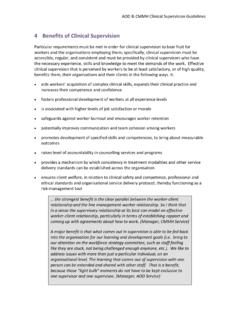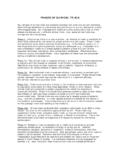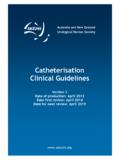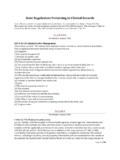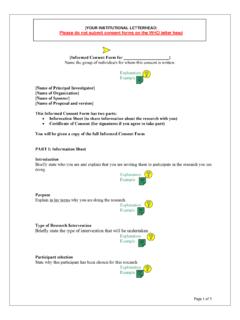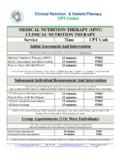Transcription of How to Build Risk Management into Clinical Trial1
1 This article reprinted and published with the permission of WCI. How to Build Risk Management into Clinical Trials We live in an age where we wish to de risk our investments. Today in the highly competitive pharmaceutical sector, if you don t spot potential risks before they become a danger to the patient, and a regulator can prove you had the information to mitigate them, you are liable to face one or more of the following: closure of your business unit, a prosecution case that could lead to a jail sentence, and personal responsibility for the serious illness or death of a patient. Never before has it been so important for Clinical Trials teams to be alert for signals that point them in the direction of possible risks . Clinical teams should avoid the trap of being locked into rules, regulations and habits which means they are failing to pay attention to all available evidence about a trial or product which could be highlighting potential risks .
2 This information comes from all types of sources. This can include insight that hint of potential problem areas in their product or trial design. However, because a Clinical Research Organization (CRO), does not want to provide the sponsor with bad news they may be tempted to ignore or gloss over concerns expressed by patients or doctors because they do not fit the protocol or the regulations. Sponsors need to actively encourage CROs to share all observations and findings. Discard the old fashioned perception that some findings as negative findings and resist the temptation to just focus on the positives that are perceived as regulatory requirements for approval. Processes must be in place to capture all pieces of information, both expected and unexpected, so that data can be extracted where required, but more importantly decisions can be made about how this information contributes to the accrual of knowledge about benefit risk.
3 A publication of OmniSure Consulting Group This article reprinted and published with the permission of WCI. Out with old habits and rules, and in with pro activity and imagination. Traditionally, the whole Clinical Trials environment is structured to deliver certain information in a specific way that is according to Good Clinical Practice (GCP). However, if GCP is not applied in a risk based sort of way, compliance itself becomes part of the problem by being too bureaucratic and obscuring what matters. The pharmaceutical sector needs to promote and accelerate a change in behavior and processes across Clinical teams to ensure that staff and CROs embrace all sources of information that is spontaneously (as opposed to predictably) generated from informed consent, feasibility studies and Clinical trials protocol. Clinical teams should become more open to picking up the vital clues often found here.
4 A balance needs to be found to redefine risk based approach to GCP compliance. We should work together to reduce bureaucracy and box ticking mentality which adds nothing to Safety . With increased GCP inspections in the , working with regulators to define and develop risk based compliance is required if we want to avoid situations where everything becomes important after an inspection. So, where might Clinical trials teams find this evidence and how to start using it? Well, how about asking and examining how the investigators are going about getting information from the patients? Could there be a better way, a way that paints a broader picture, with wider feedback and perspective on the product? Perhaps relatives have noticed a change in patient behavior that the patient hasn t noticed or can t articulate, that can tell us something interesting about the trial design or use of drug?
5 And perhaps Doctors are not recommending the drug to their clients why? Is there something around its ease of use or after effects that, if reported now, can be refined to mitigate potential risk down the line? Developing best practice and joined up thinking. Clinical teams need to develop some best practice around getting as much knowledge as possible in their trials. More joined up thinking is needed across the team, and the Clinical Research Associate (CRA) and Project Manager responsible will need to be bought in and alert to receiving all types of information. They should be coached in spotting, reporting and sharing risk. Ultimately it is key stakeholder s attitudes that will make the difference and influence the success of the new approach. The CRA has a fundamental safety responsibility to be a gatekeeper and link what is happening in the field to what is taking place internally, and spot trends and pick up and share best practice across global sites.
6 An additional layer of protection to further de risk what you do. It is clear that the new era requires a change in behavior from CROs and a change in mindset for many Clinical teams, but what about a framework that supports this new approach and offers a best practice and structured way to Build risk Management into all key processes? Risk Management is the process of first identifying and then measuring, or assessing, risks and developing strategies to manage it. Strategies include transferring the risk to another party, avoiding the risk, reducing the negative effect of the risk, and accepting some or all of the consequences of a particular risk. In ideal risk Management , a prioritization process is followed whereby the risks with the greatest impact and the greatest probability of occurring are handled first, and risks with lower probability of occurrence and lower impact are handled in descending order.
7 In practice the process can be very difficult, and balancing between risks with a high probability of occurrence but lower impact versus a risk with high impact but lower probability of occurrence can often be mishandled. Intangible risk Management identifies a new type of risk a risk that has a 100% probability of occurring but is ignored by the organization due to a lack of identification ability. For example, when deficient knowledge is applied to a situation, a knowledge risk materializes. Relationship risk appears when ineffective collaboration occurs. Process engagement risk may be an issue when ineffective operational procedures are applied. These risks directly reduce the productivity of knowledge workers, decrease cost effectiveness, profitability, service, quality, reputation, brand value, and earnings quality. Intangible risk Management allows risk Management to create immediate value from the identification and reduction of risks that reduce productivity.
8 This article reprinted and published with the permission of WCI. A tried and tested risk Management framework. There is now a tried and tested Risk Management framework that will enable you to spot, record and mitigate drug safety risks before their impact occurs, in a structured way. It s already producing great results in Pharma Manufacturing and Drug Safety. And early adopters are trialing it in their units right now, with a view to rolling it out across the globe. The new approach merges proven methodologies such as Failure Mode Effect Analysis (FMEA) with best practice risk Management . FMEA is a method that examines potential failures in products or processes. It may be used to evaluate risk Management priorities for mitigating known threat vulnerabilities. FMEA helps select remedial actions that reduce cumulative impacts of life cycle consequences ( risks ) from a systems failure (fault).
9 The basic process is to take a description of the parts of a system, and list the consequences if each part fails. In most formal systems, the consequences are then evaluated by three criteria and associated risk indices: severity (S), likelihood of occurrence (O), and detectability (D). Each index ranges from lowest risk to highest risk. The overall risk of each failure is called Risk Priority Number (RPN) and the product of Severity (S), Occurrence (O), and Detection (D) rankings: RPN = S O D. The RPN is used to prioritize all potential failures to decide upon actions leading to reduce the risk, usually by reducing likelihood of occurrence and improving controls for detecting the failure. The process is a unique amalgamation of the classic risk Management steps and FMEA and breaks down into five key steps. The Risk Management Framework This article reprinted and published with the permission of WCI.
10 The first is identifying the risk tracking information gleaned from sources such as questionnaires, audit reports, meetings and conference calls. Step 2 is Analysis what system/process/component is affected by the risk. Impact how big is the risk if it happened? Could it harm the patient, the business, or both? Each risk is assessed and scored as to its scale of impact. Calculate the likelihood of it happening by the scale of impact and you have your priorities, and a clear indication of where to focus your resources. Prioritize and Plan The next step is a plan of mitigation actions to stop the high priority risks turning into anything more serious. Control and Report This article reprinted and published with the permission of WCI. Monitor and Review Effectiveness of Actions This is followed by Control and Report , which enables you to track and monitor your actions.

